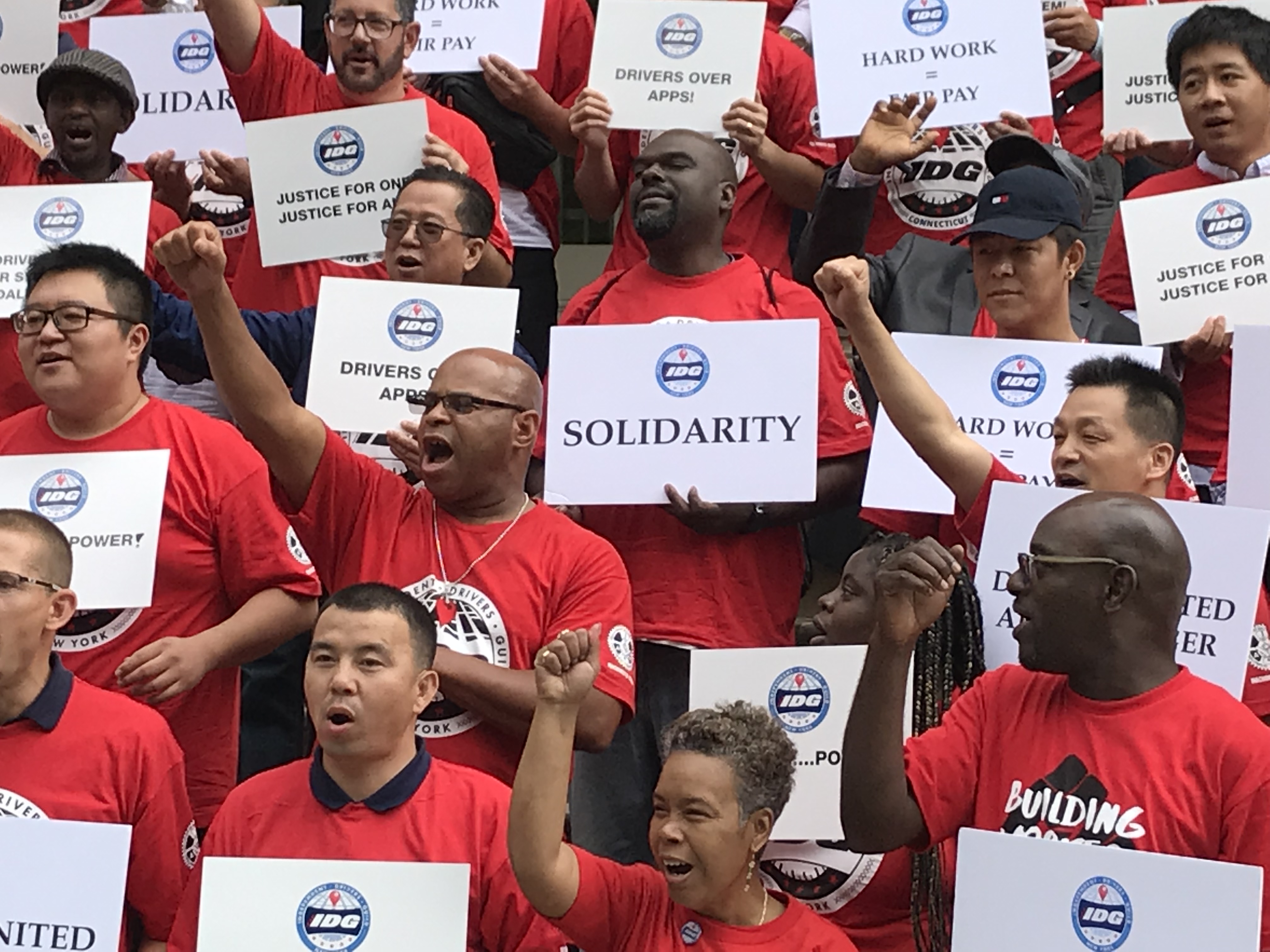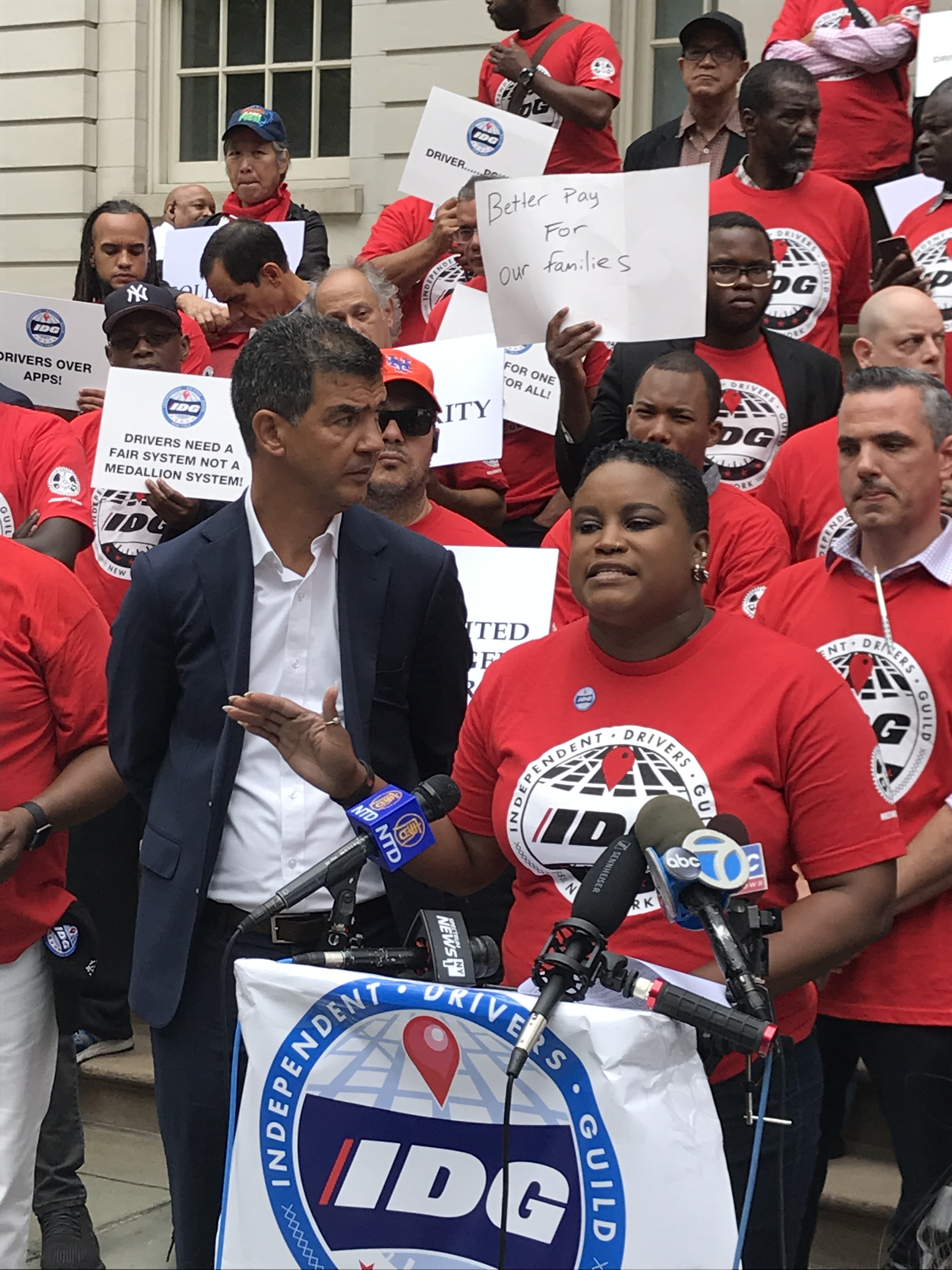NEW YORK, N.Y.—Saying that the city is “failing 80,000 low-income app-based drivers,” Independent Drivers Guild head Brendan Sexton on Sept. 10 called for abolishing the Taxi and Limousine Commission and replacing it with a mayoral agency.

Speaking to reporters and about 100 drivers at a rally in front of City Hall, Sexton said that drivers’ earnings after expenses had failed to reach the $17-an-hour minimum wage that went into effect in February, and that the city’s cap on the number of for-hire-vehicle licenses was creating “another failed medallion system” that “exacerbated predatory lending.”
With a City Council Transportation Committee hearing on the effects of those laws held that afternoon, the IDG called for a “drivers’ bill of rights” that would include enforcing the minimum wage; preventing app-based taxi companies from deactivating drivers without due process; regulating “predatory leasing” and letting owners have rooftop ads on their vehicles; various safety regulations; and restoring “destination filters,” which enable a driver to select fares going in a direction they want.
The TLC disputes the IDG’s claims that average wages for app-based drivers have gone up by only $6,000 a year, short of the $10,000 needed to reach the new minimum wage. Acting Commissioner William Heinzen told the Council that while they wouldn’t have a precise annual figure until the law had been in effect for a year, its data from the first five months showed drivers on track to take home at least $9,000 more.
The IDG is also advocating repealing the cap on licenses for new app-based cabs and replacing it with limits on the number of drivers. That cap, Sexton told the Council, “incentivizes a return to yellow-taxi-like 12-hour shifts,” and that with 12,000 new drivers issued licenses in the past year, there are now 187,000 FHV-licensed drivers, more than 60,000 above the number of licensed vehicles.
According to TLC figures, while the number of yellow cabs has been capped at 13,587 since 2014, the number of for-hire vehicles has more than doubled since then, from 58,295 to 120,954. “We have seen the rapid growth in the FHV sector have a negative economic impact on all drivers as their incomes have fallen due to the increased competition for passengers,” Council Transportation Committee chair Ydanis Rodriguez (D-Manhattan) said at the hearing.
The vehicle cap was supposed to ease traffic congestion, driver Aziz Bah told the rally, but the result has been that new drivers go to leasing companies, and have to work 14 to 18 hours a day.
Sexton said the best way to limit congestion and excessive competition was by creating a “pathway for drivers to own their own vehicles.”
“We don’t have reason to believe the city’s policies to manage congestion and protect driver pay are increasing lease costs,” TLC spokesperson Rebecca Harshbarger told LaborPress. “We reviewed the lease rates for popular FHV leasing companies, and the rates are comparable to those before the cap when we last reviewed rates.”
About 80% of app-based drivers own their vehicles, the TLC estimates. “Drivers are not treating for-hire vehicle licenses like medallions,” Harshbarger says. This year, she added, more than 8,000 for-hire vehicle owners did not renew their TLC vehicle licenses.
Rodriguez told the rally he favored “reorganizing” the TLC, and that tech companies should hire drivers as employees, which would mean employers would have to pay minimum wage, Social Security, and workers’ compensation. “These are not independent contractors,” he said. “These drivers work for those companies.”
A bill currently pending in the California legislature would declare app-based workers employees instead of independent contractors, the standard “gig economy” business model. Uber and Lyft have strenuously opposed that bill, threatening to campaign for a ballot initiative that would repeal it if it passes. The two companies unsuccessfully tried to persuade California unions to support a compromise that would let workers have union representation without collective bargaining or employee status, an arrangement similar to what Uber and the IDG have in New York.
Asked if he supported that bill, Sexton told reporters that it would lead to “lawsuits dragged out for years,” and that the IDG was primarily concerned with things that would improve drivers’ lives right now.

Another driver complaint is that app-based companies have modified their procedures in ways that make life harder for drivers. Lyft responded to limits on the number of unoccupied app-based cabs cruising the city’s streets by turning off the app during low-demand periods. IDG member Tina Raveneau, a Brooklyn single mother, told LaborPress that meant she could drive from 5 to 9 during the morning rush hour, when she’s getting her son off to school, but not from 9 a.m. to 3 p.m., when he’s in school.
She switched to Uber, she said, but that brought another problem: Uber had turned off its destination filter. That means, she explained, that when she has to pick up her son at school at 3 p.m., she can’t use the filter to ensure that her last fare will be going toward Brooklyn. Instead, she has to prepare to stop working as early as 1 p.m.
“We came into this business for flexibility,” she said.



